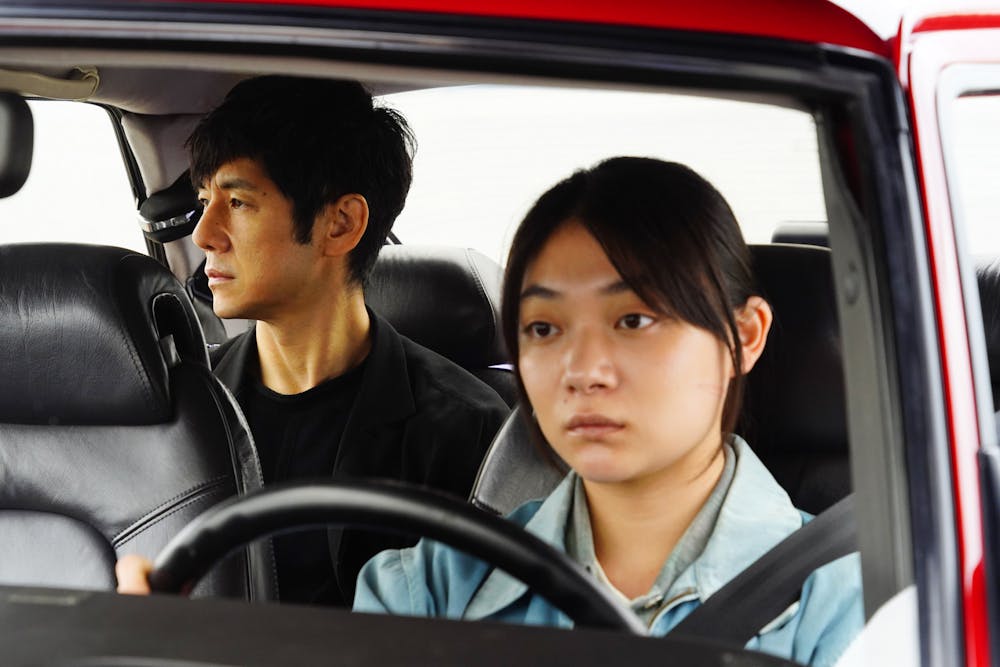As the opening credits appear 40 minutes into this film, the viewer may realize that not everything is as it seems. In director Ryusuke Hamaguchi’s hands, the delayed appearance of something as simple as a title card — a common feature in the beginning of films — pivots the viewer into a different kind of movie experience. The title card’s placement denotes that everything before it was merely preamble, and that there is much more coming in this 180-minute runtime. The film moves at its own pace — it decides how much time is enough to convey its message, and miraculously for a movie this long, it is never wrong with its decision. The movie is not a race to the finish nor is it a road trip where you ask “are we there yet?” every five minutes. It’s a smooth coast along a scenic road driven by the hands of someone you immediately put your trust in.
Based on the short story by Haruki Murakami, “Drive My Car” follows Yusuke Kafuku (Hidetoshi Nishijima) a widowed theater actor who goes to Hiroshima for a two-month artist’s residency to direct a production of Anton Chekhov’s “Uncle Vanya.” This production is unique in that every actor speaks a different language and portrays a character of a different age from their own. Kafuku casts Koji Takatsuki (Masaki Okada), the former lover of Kafuku’s late wife who cheated on Kafuku frequently, as the titular character in the play. As part of the residency, Kafuku is given a driver, the young Misaki Watari (Toko Miura), to take him back and forth from the theater to his residence outside of the city each day. The heart of the film is split between Kafuku directing his avant-garde production, trying to work through the language barriers among the actors, and the conversations between Kafuku and Watari as they work through their past traumas together. It is a dialogue-heavy movie and the script hits the perfect balance of every line being poignant to the film while also being incredibly naturalistic in its delivery.
As a literary adaptation, “Drive My Car” is a masterclass in capturing the essence of established works while also justifying itself as something unique. Hamaguchi and Murakami differ greatly in the way they fill the contents of their stories — Hamaguchi is a filmmaker often lauded for his portrayals of complex, well-developed female characters, whereas Murakami is near-unanimously criticized for his glaring lack thereof. Hamaguchi strays from Murakami by highlighting female characters that were all but missing in the source material. Park Yoo-rim plays Lee Yoon-a, a deaf Korean actress, and her performance is easily one of the best of the past release year. Although her voice is never heard and she only converses by way of interpreter, her facial expressions and displays of emotion create an astonishingly honest portrayal. Park’s portrayal, alongside an equally spellbinding performance from Nishijima, creates a scene toward the very end of the film that is one of the most enthralling moments put to screen, even though it is just two people on a bare-bones play set. Park’s immensely convincing performance ties up the film on a profoundly emotional note.
While Hamuguchi deviates from Murakami’s portrayal of women, he keeps the air of mystery and existential gloom that lingers in Murakami’s writing. Throughout the film, from the death of Kafuku’s wife to the past of Watari to the emotional instability of Takatsuki, this tone is what drives the intrigue within all the interpersonal dynamics. Many of these ideas are explored through the conversations during Watari and Kafuku’s time in the car together. These mysteries are not mysteries that are set out to be solved, but mysteries of life that are meant to be explored and ultimately accepted as constants.
But Murakami is not the only literary titan at play in this movie. Where Murakami serves as the establisher of tone and plot, Chekhov provides much of the interpersonal psychology present throughout the film. Almost every time Kafuku is in the car, a tape of Vanya’s dialogue is playing . In the rehearsal scenes, long stretches of the play are acted out without much cutting. The way Hamaguchi selects scenes of the play to pair with pivotal moments in the film makes it seem as though “Drive My Car” is not only relying on “Uncle Vanya” — “Uncle Vanya” is relying on “Drive My Car.” It is a monumental feat that such a relatively new, up-and-coming director is able to expertly balance the style of two of the most revered writers of the past two centuries within a completely new medium.
The descriptors that can be used for this film — from enthralling to captivating to epic — are words you would expect from high-budget, high-octane action movies. “Drive My Car” can achieve the same sensationalized buzzwords just through its honesty and commitment to the craft. It is not that the movie doesn’t feel like it is three hours long, it is that you are so engrossed in this little slice of these characters’ lives that you don’t care how long it takes. In fact, you will probably wish it went on for longer.
“Drive My Car” is not flashy. It might not sound particularly remarkable nor entertaining, but once watched, it becomes all of those things and then some. When done properly, nothing is more impactful than reflections of real life. “Drive My Car” is about as honest and true as any movie can get. Kafuku never tries to find some new love to fill the void left by his wife’s death, nor does he try to punish the man who she cheated on him with. His arc is monumental in its mundanity. It might be a better world if there were more movies like “Drive My Car” out there, but it is still pretty great that one like it exists.

Finn Kirkpatrick was the senior editor of multimedia of the Brown Daily Herald's 134th editorial board. He is a junior from Los Angeles, California studying Comparative Literature and East Asian Studies. He was previously an arts and culture editor and has a passion for Tetris and Mario Kart.





